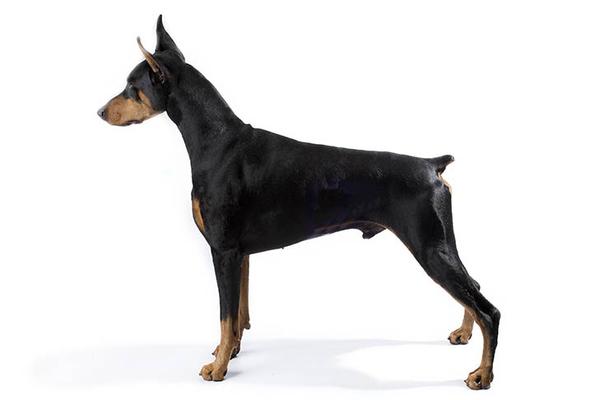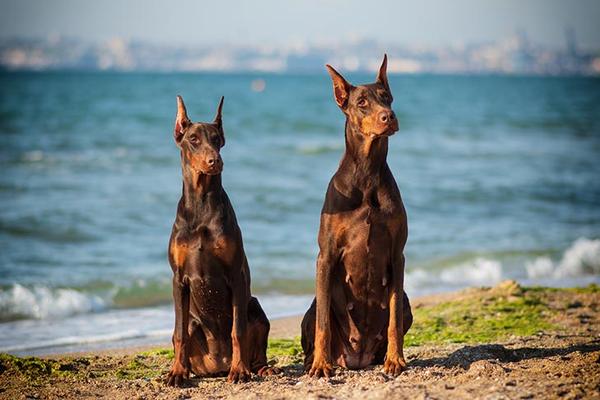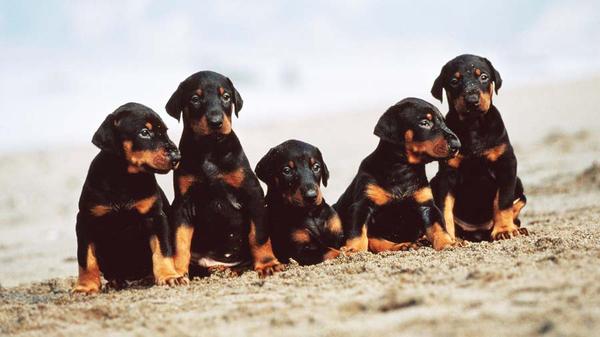Doberman Pinscher
also known as Dobermann, Dobie, Doberman, Dobynm

 History
History
The Doberman Pinscher is a breed with a rich and fascinating history. Developed in the late 19th century by Karl Friedrich Louis Dobermann, a tax collector, night watchman, dogcatcher, and flayer of dogs, in Apolda, Germany, the Doberman was created to be the ultimate protector.
During his line of work, Dobermann was constantly at risk of danger and needed a loyal companion that could help him keep safe. So, he began breeding a variety of different dogs, mixing and matching different breeds to create the perfect guard dog. Some say that he used the German Pinscher, others argue that it was the Old German Shepherd, and some even speculate that it was the Beauceron, a French dog that was transported to Germany by Napoleon’s army. The truth is, Dobermann employed so many breeds that no single one predominates, and the majority of early Doberman lines were most likely mixed and stray dogs.
Dobermann’s goal was to create a dog that was intelligent, fearless, and had a natural protective instinct. He wanted a dog that would be a loyal companion and a trustworthy friend. As he began his breeding efforts, he quickly realized that he needed a dog that was not only physically strong but also had a strong spirit and an unflappable temperament.
The Doberman Pinscher was first presented to the public in 1863 at Apolda's inaugural dog market, where it stood out for its depth of character. After Dobermann's death, attention began to be paid to the breed’s appearance as much as its working ability. Around the turn of the 20th century, crosses were made to two English breeds – the black-and-tan Manchester Terrier and the Greyhound – giving the breed some of its streamlined fluidity.
The Doberman Pinscher quickly gained recognition and popularity, and by 1908, it was officially recognized by the American Kennel Club (AKC) as a member of the Working Group. In 1921, the Doberman Pinscher Club of America was founded by George Earle III, an American diplomat who also served as governor of Pennsylvania from 1935 to 1939, to promote and protect the breed in the United States. Throughout the 1920s, interest in the breed increased, likely due to World War I veterans wanting a guard dog to protect their newly acquired properties.
During World War II, Doberman Pinschers played a vital role in supporting the military. They were used as sentries, couriers, and even scouts. A memorial statue of a Doberman stands in Guam to commemorate the 25 marine war dogs that gave their lives to free it.
The breed name "Doberman Pinscher" comes from the surname of its creator, Karl Friedrich Louis Dobermann, and the word "Pinscher," which is a German term for a terrier-like dog. Dobermann being the creator and breeder of this dog and Pinscher for the terrier-like characteristics of the dog.
Today, the Doberman Pinscher is still known for its intelligence, loyalty, and protective nature. They are still used as guard dogs, police dogs, and military dogs, but they are also highly trainable and excel in obedience and agility competitions. They make excellent companions for active individuals and families, but early socialization and training is crucial for them to become well-behaved, well-adjusted members of the family.
Breed Information
Is Doberman Pinscher a purebred?
Purebred
How do you pronounce the Doberman Pinscher name? How do you say Doberman Pinschers?
doh-ber-muh n PIN-sher
What were Doberman Pinschers originally used for?
Guardian
How Long Do Doberman Pinschers Live? What is average life expectancy for a Doberman Pinscher? How long can Doberman Pinschers live?
10-12 years
The average Doberman Pinscher lifespan is somewhere between 10-12 years, provided they aren't beset by any exceptional health issues or injuries.
Doberman Pinscher Height & Weight
How big is a full grown Doberman Pinscher?

| Height | ||||
|---|---|---|---|---|
| Average | 6 months | 12 months | 18 months | |
| Male | 26-28 inches (66 - 71.1 cm) | 20.0 inches (50.8 cm) | 25.0 inches (63.5 cm) | 27.0 inches (68.6 cm) |
| Female | 24-26 inches (61 - 66 cm) | 17.5 inches (44.5 cm) | 23.0 inches (58.4 cm) | 25.0 inches (63.5 cm) |
| Weight | ||||
|---|---|---|---|---|
| Average | 6 months | 12 months | 18 months | |
| Male | 70-100 pounds (32 - 45 kg) | 37.5 pounds (17 kg) | 67.5 pounds (31 kg) | 80.0 pounds (36 kg) |
| Female | 60-90 pounds (27 - 41 kg) | 33.0 pounds (15 kg) | 55.0 pounds (25 kg) | 67.5 pounds (31 kg) |
Do Doberman Pinschers get fat easily?
![]()
![]()
![]()
![]()
![]()
The Doberman Pinscher is a breed that has an average risk of becoming obese. Daily walks and a balanced diet of quality dry dog food can help maintain a healthy weight. An active lifestyle and monitoring weight regularly is recommended.
Are Doberman Pinschers Hypoallergenic?
No
Unfortunately, the Doberman Pinscher is not hypoallergenic, making it not a good choice for a dog lover who suffers from pet allergies.
What is a Doberman Pinscher personality? What are Doberman Pinscher dogs best known for?
Alert
Fearless
Loyal
Energetic
Intelligent
Obedient
Are Doberman Pinschers heavy shedders? How Much Does a Doberman Pinscher Shed?
![]()
![]()
![]()
![]()
![]()
Doberman Pinscher dogs are not heavy shedders, but they will lose a significant amount of hair each year. To decrease the amount of shedding, you can regularly brush your Doberman Pinscher. This will remove loose hair and keep his coat growing in the same direction.
What is the watchdog ability of a Doberman Pinscher dog?
![]()
![]()
![]()
![]()
![]()
The Doberman Pinscher dog is one of the best choice if you want a good watchdog. This breed will keep watch over you and your family at all times. This breed takes this task seriously and will typically perform its guarding duty with little to no training. This dog will require obedience training, or you can consider guard dog training to sharpen its skills.
Breed History
Where do Doberman Pinschers come from?
Germany
What are Doberman Pinschers descended from?
Rottweiler, German Pinscher, Weimaraner
What organizations or kennel clubs recognize/register the Doberman Pinscher breed?
American Canine Registry
American Kennel Club
America's Pet Registry
Canadian Kennel Club
Dog Registry of America Inc.
Federation Cynologique Internationale
Kennel Club of Great Britain
North American Purebred Registry, Inc.
American Canine Association, Inc.
Australian National Kennel Council
Continental Kennel Club
New Zealand Kennel Club
United Kennel Club
Canadian Canine Registry
When were Doberman Pinschers first bred? How old is the Doberman Pinscher breed?
1900s
What Breed Group is a Doberman Pinscher?
Working (AKC:1908)
Guardian Dogs (UKC)

Doberman Pinscher Appearance
What color are Doberman Pinscher eyes?
Hazel
Brown
What color can Doberman Pinscher nose be naturally?
Black
Brown
What color can Doberman Pinscher coat be naturally?
Black
Brown
Red
Blue
Fawn
How long is a Doberman Pinschers coat?
![]()
![]()
![]()
![]()
![]()
Doberman Pinschers are known for their short coat.
How Dense Is The Doberman Pinscher Coat?
![]()
![]()
![]()
![]()
![]()
What is the texture of the hair of a Doberman Pinscher?
Wiry
How many puppies can a Doberman Pinscher have in a litter? How many puppies can a Doberman Pinscher have in her first litter?
10-12 puppies per pregnancy
A Doberman Pinscher can have a litter of 10-12 puppies on average. However, it's worth noting that the size of the litters can vary greatly. Factors that can influence litter size include the health of the mother, breeding history, and genetics.
![]()
![]()
![]()
![]()
![]()
Doberman Pinschers are known for their adaptability and versatility, they are capable of adapting well to a wide range of lifestyle changes and living environments. They are a highly adaptable breed, and make great companions for families and individuals of all lifestyles.

Doberman Pinscher Health Issues
Do Doberman Pinschers have a lot of health problems?
![]()
![]()
![]()
![]()
![]()
The Doberman Pinscher breed is commonly healthy with low vet costs, regular check-ups may not be as necessary but it's important to keep an eye on their health and have them checked by a veterinarian when needed.
What are the major health concerns to be aware of when owning a Doberman Pinscher?
Cardiomyopathy
Bloat
Von Willebrand's Disease
Wobbler's Syndrome
What are the less significant issues to keep in mind when it comes to Doberman Pinschers?
Bone And Joint Problems
Eye Problems
Hepatitis
What are the occasional tests recommended for Doberman Pinscher breed?
Cardiac
Dna For Vwd
Hips
X-Rays
MRI
Eye Examination

Doberman Pinscher Needs and Activities
Do Doberman Pinschers have a lot of energy?
![]()
![]()
![]()
![]()
![]()
Doberman Pinschers are known for their high energy levels, so if you're looking for a more low-key dog, this breed may not be the best choice.
Do Doberman Pinschers need socialization? How social are Doberman Pinschers?
![]()
![]()
![]()
![]()
![]()
Doberman Pinschers have average social needs compared to other breeds. They are known to be less active and independent than other breeds, and they are content with spending time alone and with their human family.
How much exercise should Doberman Pinschers get?
![]()
![]()
![]()
![]()
![]()
The Doberman Pinscher dog needs significant physical activity to maintain a healthy lifestyle. They are also well-suited for those who lead an active lifestyle and enjoy activities such as running, hiking, or other outdoor pursuits.
How much sleep should a Doberman Pinscher have? Do Doberman Pinschers sleep a lot?
![]()
![]()
![]()
![]()
![]()
The Doberman Pinscher breed is known for its moderate energy levels and normal sleep patterns, typically sleeping around 12-14 hours per day.
Does a Doberman Pinscher drool a lot?
![]()
![]()
![]()
![]()
![]()
The Doberman Pinscher is a breed that is known for drooling quite a lot. Drooling is the unintentional flow of saliva outside of the mouth and can be a normal characteristic of certain breeds. Doberman Pinscher is one of them. If you dislike the presence of drool and the potential for saliva spots on your clothes, it may be best to consider a different dog breed. Drooling is a normal part of their physiology but it's important to consider if it's something you can handle.
How much does it bark?
![]()
![]()
![]()
![]()
![]()
Doberman Pinscher dogs tends to bark less frequently than most other dogs. They tend to be quieter and less vocal than other breeds. They may only bark when necessary, such as to alert their owner of something or to communicate something. They do not bark excessively, and may not bark as much as other dogs in certain situations, such as when they are left alone.
Do Doberman Pinschers exhibit aggressive behavior to safeguard their home and territory? Do they possess a natural tendency to guard?
![]()
![]()
![]()
![]()
![]()
These dogs are known for being extremely protective and make excellent guard dogs. They possess a strong instinct to defend their territory and owners and have a high level of vigilance and alertness.
Are Doberman Pinschers mouthy?
![]()
![]()
![]()
![]()
![]()
What is the likelihood of a Doberman Pinscher running away? Do they have a tendency to explore or wander frequently?
![]()
![]()
![]()
![]()
![]()
Do Doberman Pinscher dogs have a high prey drive?
![]()
![]()
![]()
![]()
![]()
What do Doberman Pinschers enjoy doing? How do I keep my Doberman Pinscher busy?
Running, Exploring, Fetch, Tracking, Run, Speak, Play with Toys, Dog Parks, Playing, Walk, Chase, Tug-of-war, Play, Nap, Digging
What is the energy level of a Doberman Pinscher? How much energy does a Doberman Pinscher have?
High
Doberman Pinschers are high-energy dogs. They need mental as well as physical exercise. These dogs require a lot of your involvement and without it they can, and will, become problematic dogs.
![]()
![]()
![]()
![]()
![]()
How far should a Doberman Pinscher walk each week? How many miles should a Doberman Pinscher walk every week?
14 miles / week
There's really no limit to how far you walk your dog as long as they're comfortable. For Doberman Pinscher, it's at least 14 miles / week. Just remember to build distance and stamina gradually over time.
How much a Doberman Pinscher should exercise a day? How much activity does a Doberman Pinscher need?
90 minutes
In general most Doberman Pinschers usually need at least 90 minutes of exercise daily. This can be spread across the day and include all sorts of high-energy activities, like walking, running and playing.
What level of grooming should be provided for a Doberman Pinscher?
![]()
![]()
![]()
![]()
![]()
The Doberman Pinscher is a breed of dog that is known for its low grooming needs.
How often should you brush a Doberman Pinscher?
Monthly
In general Doberman Pinscher should be brushed at least once a month. Of course you can give them more frequent brushes, especially if they enjoyed it
What are the most commonly used brushing tools for Doberman Pinschers?
Slicker Brush
Nail Clipper
Costs
How many cups of food does a Doberman Pinscher eat?
3 cups
For an average 70-100 pound (32 - 45 kg) Doberman Pinscher feed 3 cups daily. But, keep in mind, the amount you feed is going to be dependent on the quality of the food you are feeding.
How Much Does a Doberman Pinscher Cost Daily?
$2.10 - $2.70 / day
The average cost of a Doberman Pinscher is somewhere $2.10 - $2.70 per day.
How Much Does a Doberman Pinscher Cost Per Month?
$55 - $73 / month
The average per month expenses of a Doberman Pinscher is between $55 - $73. This makes an average of $660 - $876 per year. It will be on the higher side when the dog is still small because it will need more frequent visits to the vet, shots.
Doberman Pinscher Characteristic
How intelligent is a Doberman Pinscher?
![]()
![]()
![]()
![]()
![]()
The Doberman Pinscher breed is considered highly intelligent and very easy to train.
How sensitive is a Doberman Pinscher dog?
![]()
![]()
![]()
![]()
![]()
This dog breed is particularly attuned to its environment and the emotions of those around it. It can be easily overwhelmed by loud noises, new environments, and unfamiliar people or animals. This dog is best suited for individuals or families who are patient, gentle, and understanding of its sensitive nature. It may also benefit from a calm and stable home environment, with a consistent routine and plenty of positive reinforcement training.
Are Doberman Pinscher dogs affectionate?
![]()
![]()
![]()
![]()
![]()
Do Doberman Pinscher do well in apartments? Are Doberman Pinschers good indoor dogs?
![]()
![]()
![]()
![]()
![]()
Doberman Pinschers are known for being excellent apartment dogs. They are fairly active indoors and will do okay without a yard.
Are Doberman Pinschers good with kids? Are Doberman Pinschers good around children?
![]()
![]()
![]()
![]()
![]()
Doberman Pinschers are average friendly dogs towards children.
Are Doberman Pinschers good for elderly?
![]()
![]()
![]()
![]()
![]()
Are Doberman Pinschers good with cats? How friendly Doberman Pinschers are toward cats?
![]()
![]()
![]()
![]()
![]()
Doberman Pinschers are an average cat friendly dog. They do well with cats, even more if raised together from puppyhood,
Do Doberman Pinscher dogs get along with other dogs? Are Doberman Pinschers OK with other dogs?
![]()
![]()
![]()
![]()
![]()
Doberman Pinschers are below average dog friendly dogs. Doberman Pinscher dogs may not always get along well with other dogs they have not been raised with,
How do Doberman Pinscher dogs interact with other pets? Are they considered pet-friendly?
![]()
![]()
![]()
![]()
![]()
Are Doberman Pinschers friendly with strangers?
![]()
![]()
![]()
![]()
![]()
Doberman Pinschers are not stranger friendly dogs.
Do Doberman Pinschers like to play? Are Doberman Pinschers playful?
![]()
![]()
![]()
![]()
![]()
Doberman Pinschers have an average level of playfulness. The Doberman Pinschers, like other dogs, like to play. But they are not the most playful dog breed.
Are Doberman Pinscher easily trained?
![]()
![]()
![]()
![]()
![]()
Doberman Pinscher dogs are usually easy to train, but may require consistency to fully obey commands.
 Pros & Cons
Pros & Cons
Pros
- Intelligent
Doberman Pinschers are highly intelligent and easily trainable. - Quiet
The Doberman Pinscher dog is known for being relatively peaceful, making it a good choice if you're looking for a quieter dog. - Alert and protective
Doberman Pinschers are known to be alert and protective, making them good watchdogs. - Apartment Friendly
Doberman Pinscher are the perfect breed for apartment living. - Active
Doberman Pinschers are active and energetic, making them well-suited for families with an active lifestyle.
Cons
- Not suitable for office environment
An office is not the best place for a Doberman Pinscher. - Not Hypoallergenic
People prone to allergies may have a reaction to Doberman Pinschers, as they are not considered a hypoallergenic breed. - Training and socialization required
Doberman Pinschers require consistent training and socialization to prevent aggressive behavior.
Compare Doberman Pinscher with other dogs
- Doberman Pinscher vs Labrakita
- Doberman Pinscher vs Aussie Siberian
- Doberman Pinscher vs Saint Berdoodle
- Doberman Pinscher vs Toy Fo-Tzu
- Doberman Pinscher vs Pharaoh Hound
- Doberman Pinscher vs Golden Dox
- Doberman Pinscher vs Lhasalier
- Doberman Pinscher vs Doberman Collie
- Doberman Pinscher vs Havanese
- Doberman Pinscher vs Silky Terrier